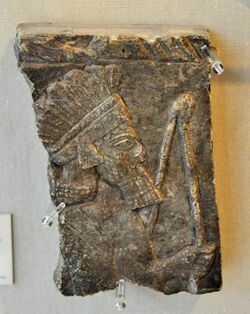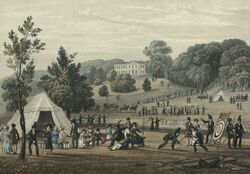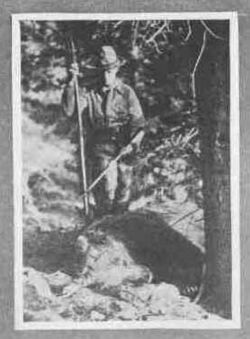Engineering:History of archery
Archery, or the use of bow and arrows, was probably developed in Africa by the later Middle Stone Age (approx. 70,000 years ago; also known outside of Africa as the Middle Palaeolithic). It had been an important military and hunting tactic throughout history, and figures prominently in the mythologies of many cultures.[1] Archers, whether on foot, in chariots or mounted on horses were a major part of most military forces for many years.
Archery was supplemented (and eventually replaced) by firearms in the Late Middle Ages and early modern period. Gunpowder was invented in the 9th century and was used to enhance projectile weapons (including arrows). Firearms eventually diffused throughout Eurasia via the Gunpowder empires, gradually reducing the importance of archery in warfare.
Nonetheless, archery is still practiced today, including in the training regime of certain special forces. It also continues to be a popular sport, most commonly in the form of target archery, but in some places also for hunting.
Prehistory
Paleolithic and Epipaleolithic
The oldest known evidence of arrows comes from South African sites such as Sibudu Cave, where likely arrowheads have been found, dating from approximately 72,000–60,000 years ago,[2][3][4][5][6][7] on some of which poisons may have been used.[2]
The earliest probable arrowheads found outside of Africa have been discovered in 2020 in Fa Hien Cave, Sri Lanka. It has been dated to 48,000 years ago. "Bow-and-arrow hunting at the Sri Lankan site likely focused on monkeys and smaller animals, such as squirrels... Remains of these creatures were found in the same sediment as the bone points."[8][9]
At the site of Nataruk in Turkana County, Kenya, obsidian bladelets found embedded in a skull and within the thoracic cavity of another skeleton, suggest the use of stone-tipped arrows as weapons about 10,000 years ago.[10]
In the Sahara, Mesolithic rock art of the Tassili plateau depicts people carrying bows from 5,000 BP or earlier.[11][12]
Based on indirect evidence, the bow seems also to have appeared or reappeared later in Eurasia around the Upper Paleolithic.
In the Levant, artifacts which may be arrow-shaft straighteners are known from the Natufian culture, (ca. 12,800–10,300 BP) onwards. The Khiamian and PPN A shouldered Khiam-points may well be arrowheads.
Possible fragments of a bow found at Mannheim-Vogelstang have been dated to the Early Magdelenian age (c. 17,500 to 18,000 years ago) and at Stellmoor dated 11,000 years ago.[13] Azilian points found in Grotte du Bichon, Switzerland, alongside the remains of both a bear and a hunter, with flint fragments found in the bear's third vertebra, suggest the use of arrows at 13,500 years ago.[14]
Other early indications of archery in Europe come from Stellmoor in the Ahrensburg valley north of Hamburg, Germany. They were associated with artifacts of the late Paleolithic (11,000–9,000 BP). The arrows were made of pine and consisted of a mainshaft and a 15–20 centimetre (6–8 inches) long foreshaft with a flint point. They had shallow grooves on the base, indicating that they were shot from a bow.[15]
The oldest definite bows known so far come from the Holmegård swamp in Denmark. In the 1940s, two bows were found there, dated to about 8,000 BP.[16] The Holmegaard bows are made of elm and have flat arms and a D-shaped midsection. The center section is biconvex. The complete bow is 1.50 m (5 ft) long. Bows of Holmegaard-type were in use until the Bronze Age; the convexity of the midsection has decreased with time.
Mesolithic pointed shafts have been found in England, Germany, Denmark, and Sweden. They were often rather long, up to 120 cm (4 ft) and made of European hazel (Corylus avellana), wayfaring tree (Viburnum lantana) and other small woody shoots. Some still have flint arrow-heads preserved; others have blunt wooden ends for hunting birds and small game. The ends show traces of fletching, which was fastened on with birch-tar.
The oldest depictions of combat, found in Iberian cave art of the Mesolithic, show battles between archers.[17] A group of three archers encircled by a group of four is found in Cueva del Roure, Morella la Vella, Castellón, Valencia. A depiction of a larger battle (which may, however, date to the early Neolithic), in which eleven archers are attacked by seventeen running archers, is found in Les Dogue, Ares del Maestrat, Castellón, Valencia.[18] At Val del Charco del Agua Amarga, Alcañiz, Aragon, seven archers with plumes on their heads are fleeing a group of eight archers running in pursuit.[19]
Archery seems to have arrived in the Americas via Alaska, as early as 6000 BC,[20] with the Arctic small tool tradition, about 2,500 BC, spreading south into the temperate zones as early as 2,000 BC, and was widely known among the indigenous peoples of North America from about 500 AD.[21]
Neolithic
The oldest Neolithic bow known from Europe was found in anaerobic layers dating between 7,400 and 7,200 BP, the earliest layer of settlement at the lake settlement at La Draga, Banyoles, Girona, Spain. The intact specimen is short at 1.08m, has a D-shaped cross-section, and is made of yew wood.[22] Stone wrist-guards, interpreted as display versions of bracers, form a defining part of the Beaker culture and arrowheads are also commonly found in Beaker graves. European Neolithic fortifications, arrow-heads, injuries, and representations indicate that, in Neolithic and Early Bronze Age Europe, archery was a major form of interpersonal violence.[23] For example, the Neolithic settlement at Carn Brea was occupied between around 3700 and 3400 BC; excavations found that every timber structure on the site had been burnt, and there was a concentration of arrow heads around a probable entrance to the enclosure; these arrows may have been used by a large group of archers in an organized assault.[24][25] [26]
Bronze Age
Chariot-borne archers became a defining feature of Middle Bronze Age warfare, from Europe to Eastern Asia and India. However, in the Middle Bronze Age, with the development of massed infantry tactics, and with the use of chariots for shock tactics or as prestigious command vehicles, archery seems to have lessened in importance in European warfare.[23] In approximately the same period, with the Seima-Turbino Phenomenon and the spread of the Andronovo culture, mounted archery became a defining feature of Eurasian nomad cultures and a foundation of their military success, until the massed use of guns. In China, crossbows were developed, and Han Dynasty writers attributed Chinese success in battles against nomad invaders to the massed use of crossbows, first definitely attested at the Battle of Ma-Ling in 341 BC.[27]
Ancient history
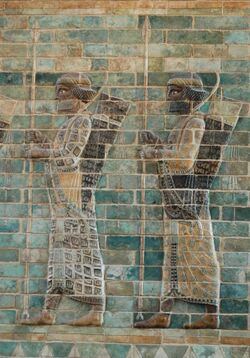
Ancient civilizations, notably the Persians, Parthians, Egyptians, Nubians, Indians, Koreans, Chinese, and Japanese fielded large numbers of archers in their armies. Arrows were destructive against massed formations, and the use of archers often proved decisive. The Sanskrit term for archery, dhanurveda, came to refer to martial arts in general. Mounted archers were used as the main military force for many of the equestrian nomads, including the Cimmerians and the Mongols.
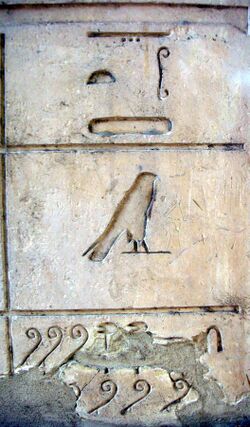
North Africa
The ancient Egyptian people took to archery as early as 5,000 years ago. Archery was widespread by the time of the earliest pharaohs and was practiced both for hunting and use in warfare. Legendary figures from the tombs of Thebes are depicted giving "lessons in archery".[28] Some Egyptian deities are also connected to archery.[29] The "Nine bows" were a conventional representation of Egypt's external enemies. One of the oldest representations of the Nine bows is on the seated statue of Pharaoh Djoser (3rd Dynasty, 27th century BC).[30] Many of the archers in service to Egypt were of Nubian extraction commonly referred to as Medjay, who go from a mercenary force during their initial service to Egypt in the Middle Kingdom to an elite paramilitary unit by the New Kingdom. So effective were the Nubians as archers that Nubia as whole would be referred to Ta-Seti or land of the bow by the Ancient Egyptians.
Mesopotamia
The Assyrians and Babylonians extensively used the bow and arrow for hunting and warfare. The empires in ancient Mesopotamia formed the first standing armies used exclusively for warfare. This included soldiers trained and employed as archers. The archers served as an integral division of the military and was used on foot and on chariots.

The Chariot warriors of the Kassites relied heavily on the bow. The Nuzi texts detail the bows and the number of arrows assigned to the chariot crew. Archery was essential to the role of the light horse-drawn chariot as a vehicle of warfare.[31]
The Old Testament has multiple references to archery as a skill identified with the ancient Hebrews. Xenophon describes long bows used to great effect in Corduene.
Three-bladed (trilobate) arrowheads have been found in the United Arab Emirates, dated to 100BC-150AD.[32]
Eurasian Steppes
The composite bow was first produced in the Eurasian Steppes during the Bronze Age, and from there it diffused throughout the Old World. The nomads from the Eurasian steppes are believed to play an integral part in introducing the composite bow to other civilizations, including Mesopotamia, Iran, India, East Asia, and Europe. There are arrowheads from the earliest chariot burials at Krivoye Lake, part of the Sintashta culture about 2100–1700 BC. These people are also believed to have invented spoke-wheeled chariots, and chariot archery became an integral component of the militaries of early Indo-Europeans.
Domestication of horses and mounted horseback archery are also believed to have originated in the Eurasian steppes. This revolutionized warfare as well as the practice of archery.

India
The use of bow and arrow was recorded extensively throughout the history of the Indian subcontinent.
The paleolithic paintings of Bhimbetka rock shelters depict archery.[33] Vedic hymns in the Rigveda, Yajurveda, and Atharvaveda lay emphasis on the use of the bow and arrow.[34] The second Veda, the Yajurveda contains Dhanurveda (dhanus "bow" and veda "knowledge"), which was an ancient treatise on the science of archery and its use in warfare. The existence of Dhanurveda or "Science of Archery" in antiquity is evident from references made in several works of ancient literature. The Viṣṇu Purāṇa refers it as one of the eighteen branches of knowledge taught, while the Mahābhārata mentions it as having sutras like other vedas. Śukranīti describes it as that 'upaveda of yajurveda' which has five arts or practical aspects. The Dhanurveda enumerates the rules of archery, and describes the uses of weapons and the training the army. Besides providing the account of the training of the archers, Vasiṣṭha's Dhanurveda describes the different types of bows and arrows, as well as the process of making them. Detailed accounts of training methodologies in early India considered to be an essential martial skill in early India.[35]
The composite bow in India was being used by 2nd millennium BCE. The bow was used extensively on foot as well on chariots. It was incorporated into the standing armies of the Mahajanapadas, and used in mounted warfare on horses, camels, and elephants with a howdah. The importance of archery continued through antiquity during the Maurya Empire. The Arthashastra, a military treaties written by Chanakya during the Maurya Era, goes in depth on the importance and implementation of archery. It also mentions an archery school at Taxila which enrolled 103 princes from different kingdoms across the empire.
During the era of the Gupta Empire mounted archery was largely supplanted by foot archers. This was in contrast to the nomadic armies on horseback from Central Asia such as the Iranian, Scythians, Parthians, Kushans, and Hunas. Later Indian kingdoms entities would maintain and field large numbers of mounted archers. The use of bows and arrows continued to be used as the mainstay of most Indian armies until the advent of firearm, introduced by Islamic gunpowder empires.[36][37]
Greco-Roman antiquity
The people of Crete practiced archery and Cretan mercenary archers were in great demand.[38] Crete was known for its unbroken tradition of archery.[39]
The Greek god Apollo is the god of archery, also of plague and the sun, metaphorically perceived as shooting invisible arrows. Artemis goddess of the hunt, Heracles and Odysseus, and many other mythological figures are often depicted with a bow.
During the invasion of India, Alexander the Great personally took command of the shield-bearing guards, foot-companions, archers, Agrianians and horse-javelin-men and led them against the Kamboja clans—the Aspasioi of Kunar valleys, the Guraeans of the Guraeus (Panjkora) valley, and the Assakenois of the Swat and Buner valleys.[40]
The early Romans had very few archers, if any. As their empire grew, they recruited auxiliary archers from other nations. Julius Caesar's armies in Gaul included Cretan archers, and Vercingetorix his enemy ordered "all the archers, of whom there was a very great number in Gaul, to be collected".[41] By the 4th century, archers with powerful composite bows were a regular part of Roman armies throughout the empire. After the fall of the western empire, the Romans came under severe pressure from the highly skilled mounted archers belonging to the Hun invaders, and later Eastern Roman armies relied heavily on mounted archery.[42]
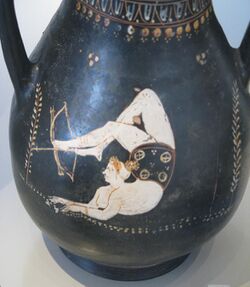
East Asia
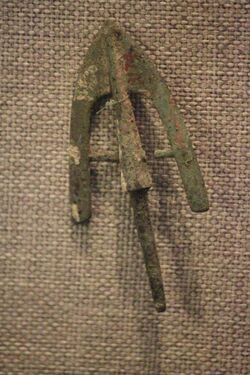
For millennia, archery has played a pivotal role in Chinese history.[43] In particular, archery featured prominently in ancient Chinese culture and philosophy: archery was one of the Six Noble Arts of the Zhou dynasty (1146–256 BC); archery skill was a virtue for Chinese emperors; Confucius himself was an archery teacher; and Lie Zi (a Daoist philosopher) was an avid archer.[44][45] Because the cultures associated with Chinese society spanned a wide geography and time range, the techniques and equipment associated with Chinese archery are diverse.[46]
In East Asia Joseon adopted a military-service examination system from China,[47] and South Korea remains a particularly strong performer at Olympic archery competitions even to this day.[48][49]
Medieval history
At the turn of the era in the 4th century, Vegetius wrote in his De Re Militari about the importance of archery. His reforms to focus on a master overseeing the training of a third or fourth of recruits in archery would shape the rest of the medieval period in the west.[50]
The Sasanian general Bahram Chobin has been credited with writing a manual of archery in the tenth century in Ibn al-Nadim's catalogue Kitab al-Fihrist.[51]
The Assize of Arms of 1252 tells us that English yeomen were required by law, in an early version of a militia, to practice archery and maintain their skills.
A complete arrow of 75 cm[52] (along with other fragments and arrow heads) dated back to 1283 AD, was discovered inside a cave[53] situated in the Qadisha Valley,[54] Lebanon.
We are told that 6,000 English archers launched 42,000 arrows per minute at the Battle of Crecy in 1346.[55]
A treatise on Arab archery by Ibn Qayyim Al-Jawziyya, Muḥammad ibn Abī Bakr (1292AD-1350AD) comes from the 14th century.[56]
A treatise on Saracen archery was written in 1368. This was a didactic poem on archery dedicated to a Mameluke sultan by Ṭaibughā al-Ashrafī.[57]
A 14th century treatise on Arab archery was written by Hussain bin Abd al-Rahman.[58]
A treatise, A book on the excellence of the bow & arrow of c. 1500 details the practices and techniques of archery among the Arabs of that time.[59] An online copy of the text is available.[60]
The Battle of Agincourt in 1415 is notable for Henry V's introduction of the English longbow into military lore. Henry VIII was so concerned about the state of his archers that he enjoined tennis and other frivolous pursuits in his Unlawful Games Act 1541.
An anonymous book written in Picardy, France in the late 15th century details how archery in medieval Europe was practiced. The book was titled "Le Fachon de tirer l'arc a main". It describes the means of how a yew bow could be made, the kinds of wood that could be used, how to shoot it, string it and different kind of arrows. According to the writer, its purpose is for posterity, possibly due to the rise of the gun.[61]
In Mali, the footmen were dominated by archers. Three archers to one spearman was the general ratio of Malian formations in the 16th century. The archers generally opened battle, softening up the enemy for cavalry charges or the advance of the spearmen.[62]
Decline of archery

File:Johan-van-Heemskerk-Batavische-Arcadia MGG 1334.tif
The advent of firearms eventually rendered bows obsolete in warfare. Despite the high social status, ongoing utility, and widespread pleasure of archery, almost every culture that gained access to even early firearms used them widely, to the relative neglect of archery.
"Have them bring as many guns as possible, for no other equipment is needed. Give strict orders that all men, even the samurai, carry guns."—Asano Yukinaga, 1598[63]
In Ireland, Geoffrey Keating (c. 1569 – c. 1644) mentions archery as having been practiced "down to a recent period within our own memory."[64]
Early firearms were inferior in rate of fire (a Tudor English author expects eight shots from the English longbow in the time needed for a "ready shooter" to give five from the musket),[65] and François Bernier reports that well-trained mounted archers at the Battle of Samugarh in 1658 were "shooting six times before a musketeer can fire twice".[66] Firearms were also very susceptible to wet weather. However, they had a longer effective range (up to 200 yards for the longbow, up to 600 yards for the musket),[65][67] greater penetration,[68] were extremely powerful compared to any previous man-portable missile weapon (16th century arquebuses and muskets had 1,300 to 3,000 joules per shot depending on size and powder load, as compared to 80-100 joules for a typical longbow arrow or 150-200 joules for a crossbow bolt),[69] and were tactically superior in the common situation of soldiers shooting at each other from behind obstructions. They also penetrated steel armour without any need to develop special musculature. Armies equipped with guns could thus provide superior firepower, and highly trained archers became obsolete on the battlefield. The Battle of Cerignola in 1503 was won by Spain mainly by the use of matchlock firearms, marking the first time a major battle in Europe was won through the use of firearms.
The last regular unit armed with bows was the Archers' Company of the Honourable Artillery Company, ironically a part of the oldest regular unit in England to be armed with gunpowder weapons. The last recorded use of bows in battle in England seems to have been a skirmish at Bridgnorth; in October 1642, during the English Civil War, an impromptu militia, armed with bows, was effective against un-armoured musketmen.[70] The last use of the bow in battle in Britain is said to have occurred at the Battle of Tippermuir in Scotland on 1 September 1644, when James Graham, 1st Marquess of Montrose's Royalist highlanders defeated an army of Scottish Covenanters.[71] Among Montrose's army were bowmen.[71]
Archery continued in some areas that were subject to limitations on the ownership of arms, such as the Scottish Highlands during the repression that followed the decline of the Jacobite cause, and the Cherokees after the Trail of Tears. The Tokugawa shogunate severely limited the import and manufacture of guns, and encouraged traditional martial skills among the samurai; towards the end of the Satsuma Rebellion in 1877, some rebels fell back on the use of bows and arrows. Archery remained an important part of the military examinations until 1894 in Korea and 1904 in China.
Within the steppe of Eurasia, archery continued to play an important part in warfare, although now restricted to mounted archery. The Ottoman Empire still fielded auxiliary cavalry which was noted for its use of bows from horseback. This practice was continued by the Ottoman subject nations, despite the Empire itself being a proponent of early firearms. The practice declined after the Crimean Khanate was absorbed by Russia; however mounted archers remained in the Ottoman order of battle until the post-1826 reforms to the Ottoman Army. The art of traditional archery remained in minority use for sport and for hunting in Turkey up until the 1920s, but the knowledge of constructing composite bows fell out of use with the death of the last bowyer in the 1930s. The rest of the Middle East also lost the continuity of its archery tradition at this time.
An exception to this trend was the Comanche culture of North America, where mounted archery remained competitive with muzzle-loading guns. "After... about 1800, most Comanches began to discard muskets and pistols and to rely on their older weapons."[72] Repeating firearms, however, were superior in turn, and the Comanches adopted them when they could. Bows remained effective hunting weapons for skilled horse archers, used to some extent by all Native Americans on the Great Plains to hunt buffalo as long as there were buffalo to hunt. The last Comanche hunt was in 1878, and it failed for lack of buffalo, not lack of appropriate weapons.[73]
Ongoing use of bows and arrows was maintained in isolated cultures with little or no contact with the outside world. The use of traditional archery in some African conflicts has been reported in the 21st century, and the Sentinelese still use bows as part of a lifestyle scarcely touched by outside contact. A remote group in Brazil, recently photographed from the air, aimed bows at the aeroplane.[74] Bows and arrows saw considerable use in the 2007–2008 Kenyan crisis.
Recreational revival
The British initiated a major revival of archery as an upper-class pursuit from about 1780–1840.[75] Early recreational archery societies included the Finsbury Archers and the Kilwinning Papingo, established in 1688. The latter held competitions in which the archers had to dislodge a wooden parrot from the top of an abbey tower. The Company of Scottish Archers was formed in 1676 and is one of the oldest sporting bodies in the world. It remained a small and scattered pastime, however, until the late 18th century when it experienced a fashionable revival among the aristocracy. Sir Ashton Lever, an antiquarian and collector, formed the Toxophilite Society in London in 1781, with the patronage of George, the Prince of Wales.
Archery societies were set up across the country, each with its own strict entry criteria and outlandish costumes. Recreational archery soon became extravagant social and ceremonial events for the nobility, complete with flags, music and 21 gun salutes for the competitors. The clubs were "the drawing rooms of the great country houses placed outside" and thus came to play an important role in the social networks of local elites. As well as its emphasis on display and status, the sport was notable for its popularity with females. Young women could not only compete in the contests but retain and show off their sexuality while doing so. Thus, archery came to act as a forum for introductions, flirtation and romance.[75] It was often consciously styled in the manner of a Medieval tournament with titles and laurel wreaths being presented as a reward to the victor. General meetings were held from 1789, in which local lodges convened together to standardise the rules and ceremonies. Archery was also co-opted as a distinctively British tradition, dating back to the lore of Robin Hood and it served as a patriotic form of entertainment at a time of political tension in Europe. The societies were also elitist, and the new middle class bourgeoisie were excluded from the clubs due to their lack of social status.
After the Napoleonic Wars, the sport became increasingly popular among all classes, and it was framed as a nostalgic reimagining of the preindustrial rural Britain. Particularly influential was Sir Walter Scott's 1819 novel, Ivanhoe that depicted the heroic character Locksley winning an archery tournament.[76]
A modern sport
The 1840s saw the first attempts at turning the recreation into a modern sport. The first Grand National Archery Society meeting was held in York in 1844 and over the next decade the extravagant and festive practices of the past were gradually whittled away and the rules were standardised as the 'York Round' – a series of shoots at 60, 80, and 100 yards. Horace A. Ford helped to improve archery standards and pioneered new archery techniques. He won the Grand National 11 times in a row and published a highly influential guide to the sport in 1856.
Towards the end of the 19th century, the sport experienced declining participation as alternative sports such as croquet and tennis became more popular among the middle class. By 1889, just 50 archery clubs were left in Britain, but it was still included as a sport at the 1900 Paris Olympics.
In the United States, primitive archery was revived in the early 20th century. The last of the Yahi Indian tribe, a native known as Ishi, came out of hiding in California in 1911.[77][78] His doctor, Saxton Pope, learned many of Ishi's traditional archery skills, and popularized them.[79][80] The Pope and Young Club, founded in 1961 and named in honor of Pope and his friend, Arthur Young, became one of North America's leading bowhunting and conservation organizations. Founded as a nonprofit scientific organization, the club was patterned after the prestigious Boone and Crockett Club and advocated responsible bowhunting by promoting quality, fair chase hunting, and sound conservation practices.
In Korea, the transformation of archery to a healthy pastime was led by Emperor Gojong, and is the basis of a popular modern sport. The Japanese continue to make and use their unique traditional equipment. Among the Cherokees, popular use of their traditional longbows never died out.[81]
In China, at the beginning of the 21st century, there has been revival in interest among craftsmen looking to construct bows and arrows, as well as in practicing technique in the traditional Chinese style.[82][83]
In modern times, mounted archery continues to be practiced as a popular competitive sport in modern Hungary and in some Asian countries but it is not recognized as an international competition.[84] Archery is the national sport of the Kingdom of Bhutan.[85]
From the 1920s, professional engineers took an interest in archery, previously the exclusive field of traditional craft experts.[86] They led the commercial development of new forms of bow including the modern recurve and compound bow. These modern forms are now dominant in modern Western archery; traditional bows are in a minority. In the 1980s, the skills of traditional archery were revived by American enthusiasts, and combined with the new scientific understanding. Much of this expertise is available in the Traditional Bowyer's Bibles (see Further reading). Modern game archery owes much of its success to Fred Bear, an American bow hunter and bow manufacturer.[87]
See also
- Archery
- Kyūdō, Japanese archery
- Yabusame, Japanese horseback archery
- Gungdo, Korean archery
- Turkish archery
- Chinese archery
- Archery in India
References
- ↑ Whitman, Theodore R. (2017-08-03) (in en). The History of Archery. CreateSpace Independent Publishing Platform. ISBN 978-1-9742-6255-7. https://books.google.com/books?id=GUxvswEACAAJ.
- ↑ Jump up to: 2.0 2.1 "The tip cross-sectional areas of poisoned bone arrowheads from southern Africa". Journal of Archaeological Science: Reports 33. 2020. doi:10.1016/j.jasrep.2020.102477.
- ↑ Backwell L, d'Errico F, Wadley L.(2008). Middle Stone Age bone tools from the Howiesons Poort layers, Sibudu Cave, South Africa. Journal of Archaeological Science, 35:1566–1580. doi:10.1016/j.jas.2007.11.006
- ↑ Wadley, Lyn (2008). "The Howieson's Poort industry of Sibudu Cave". South African Archaeological Society Goodwin Series 10.
- ↑ "Indications of bow and stone-tipped arrow use 64,000 years ago in KwaZulu-Natal, South Africa". Antiquity 84 (325): 635–648. 2010. doi:10.1017/S0003598X00100134.
- ↑ "Quartz-tipped arrows older than 60 ka: further use-trace evidence from Sibudu, Kwa-Zulu-Natal, South Africa". Journal of Archaeological Science 38 (8): 1918–1930. 2011. doi:10.1016/j.jas.2011.04.001.
- ↑ Backwell L, Bradfield J, Carlson KJ, Jashashvili T, Wadley L, d'Errico F.(2018). The antiquity of bow-and-arrow technology: evidence from Middle Stone Age layers at Sibudu Cave. Journal of Archaeological Science, 92:289–303. doi:10.15184/aqy.2018.11
- ↑ https://www.sciencenews.org/article/clues-earliest-known-bow-arrow-hunting-outside-africa-found
- ↑ Bows and arrows and complex symbolic displays 48,000 years ago in the South Asian tropics. Michelle C. Langley, Noel Amano, Oshan Wedage, Siran Deraniyagala, M.M Pathmala, Nimal Perera, Nicole Boivin, Michael D. Petraglia, and Patrick Roberts. Science Advances 12 June 2020: Vol. 6, no. 24, eaba3831DOI: 10.1126/sciadv.aba3831 https://advances.sciencemag.org/content/6/24/eaba3831 accessed 18.11.2020
- ↑ Lahr, M. Mirazón; Rivera, F.; Power, R.K.; Mounier, A.; Copsey, B.; Crivellaro, F.; Edung, J.E.; Fernandez, J.M. Maillo et al. (2016). "Inter-group violence among early Holocene hunter-gatherers of West Turkana, Kenya". Nature 529 (7586): 394–398. doi:10.1038/nature16477. PMID 26791728. https://www.repository.cam.ac.uk/handle/1810/253726.
- ↑ "digital photograph (colour) | British Museum" (in en). https://www.britishmuseum.org/collection/object/E_2013-2034-4127.
- ↑ Soukopova, Jitka (2013-01-16) (in en). Round Heads: The Earliest Rock Paintings in the Sahara. Cambridge Scholars Publishing. pp. 26–27. ISBN 978-1-4438-4579-3. https://books.google.com/books?id=07wwBwAAQBAJ.
- ↑ Gaëlle Rosendahl, Karl-Wilhelm Beinhauer, Manfred Löscher, Kurt Kreipl, Rudolf Walter, Wilfried Rosendahl, Le plus vieil arc du monde ? Une pièce intéressante en provenance de Mannheim, Allemagne, L'Anthropologie, Volume 110, Issue 3, 2006, 371-382, https://doi.org/10.1016/j.anthro.2006.06.008
- ↑ « La grotte du Bichon, un site préhistorique des montagnes neuchâteloises », Archéologie neuchâteloise 42, 2009.
- ↑ McEwen E, Bergman R, Miller C. Early bow design and construction. Scientific American 1991 vol. 264 pp76-82.
- ↑ Charles E. Grayson, Mary French, Michael J. O'Brien. Traditional Archery from Six Continents: The Charles E. Grayson Collection. University of Missouri Press 2007. ISBN:978-0-8262-1751-6 p=1
- ↑ Keith F. Otterbein, How War Began (2004), p. 72.
- ↑ Christensen J. 2004. "Warfare in the European Neolithic", Acta Archaeologica 75, 129–156.
- ↑ S.L. Washburn, Social Life of Early Man (1962), p. 207.
- ↑ Blitz, John. "Adoption of the Bow in Prehistoric North America. North American Archaeologist, vol 9 no 2, 1988". http://anthropology.ua.edu/reprints/22.pdf.
- ↑ Brian Fagan. The first North Americans. Thames and Hudson, London, 2011. ISBN:978-0-500-02120-0 Hodge, Frederick Webb (1907). Handbook of American Indians North of Mexico, Vol 1 pg 485. Government Printing Office
- ↑ Barcelona, Universitat Autonoma de. "The oldest Neolithic Bow discovered in Europe – UAB Barcelona". http://www.uab.cat/servlet/Satellite/latest-news/news-detail/the-oldest-neolithic-bow-discovered-in-europe-1096476786473.html?noticiaid=1340951938330.
- ↑ Jump up to: 23.0 23.1 Bronze Age Warfare. Richard Osgood and Sarah Monks with Judith Toms. The History Press 2000. pp.139–142
- ↑ Shadowland, Wales 300–1500 BC. Steve Burrow, National Museum of Wales / Oxbow Books, 2011, page 147
- ↑ Mercer, R.J. (1970). "The Neolithic Settlement on Carn Brea: Preliminary Report". Cornish Archaeology (Cornwall Archaeological Society) 9: 54–62. https://cornisharchaeology.org.uk/volume-9-1970/
- ↑ Mercer, R.J. (1972). "The Excavation of the Neolithic Settlement, Carn Brea". Cornish Archaeology (Cornwall Archaeological Society) 11. https://cornisharchaeology.org.uk/volume-11-1972/
- ↑ Needham (1986), Volume 5, Part 6, 124–128.
- ↑ Wilson, John (1956). The Culture of Ancient Egypt pg 186. University of Chicago Press
- ↑ Traunecker, Claude (2001). The Gods of Egypt pg 29. Cornell University Press
- ↑ "Enemies of Civilization: Attitudes toward Foreigners in Ancient Mesopotamia, Egypt, and China", Mu-chou Poo, Mu-chou Poo Muzhou Pu. SUNY Press, 1 Feb 2012. p. 43. Retrieved 7 January 2017
- ↑ Drews, Roberts (1993). The End of the Bronze Age: Changes in Warfare and the Catastrophe Ca. 1200 B.C. pg 119. Princeton University Press
- ↑ "A trilobate arrowhead can be defined as an arrowhead that has three wings or blades that are usually placed at equal angles (i.e. c. 120°) around the imaginary longitudinal axis extending from the centre of the socket or tang. Since this type of arrowhead is rare in southeastern Arabia, we must investigate its origin and the reasons behind its presence at ed-Dur."Delrue, Parsival (2007). "Trilobate Arrowheads at Ed-Dur (U.A.E, Emirate of Umm Al-Qaiwain)".". Arabian Archaeology and Epigraphy 18 (2): 239–250. doi:10.1111/j.1600-0471.2007.00281.x.
- ↑ Animals into Art, p.599, Routledge, Howard Morphy
- ↑ With the bow let us win cows, with the bow let us win the contest and violent battles with the bow. The bow ruins the enemy's pleasure; with the bow let us conquer all corners of the world. – Drews, Roberts (1993). The End of the Bronze Age: Changes in Warfare and the Catastrophe Ca. 1200 B.C. pg 125. Princeton University Press
- ↑ Scharfe, Hartmut (2002). Education in Ancient India pg 271. Brill Academic Publishers
- ↑ Zimmer, Heinrich and Campbell, Joseph (1969). Philosophies of India pg 140. Princeton University Press.
- ↑ Drews, Robert (1993). The End of the Bronze Age: Changes in Warfare and the Catastrophe Ca. 1200 B.C. pg 119. Princeton University Press
- ↑ Cambridge University Press (2000). Cambridge Ancient History pg 174.
- ↑ Kirk, Geoffrey etc (1993). The Iliad: a commentary pg 136. Cambridge University Press
- ↑ The Ashvayanas living on river Guraeus (modern river Panjkora), which are the Gauri of Mahabharata, were also known as Gorys or Guraios, modern Ghori or Gori, a wide spread tribe, branches of which are still to be found on the Panjkora and on both sides of the Kabul at the point of its confluence with Landai (See: History of Punjab, Vol I, 1997, p 227, Publication Bureau, Punjabi University, Patiala (Editors) Dr L. M. Joshi, Dr Fauja Singh). The clan name Gore or Gaure is also found among the modern Kamboj people of Punjab and it is stated that the Punjab Kamboj Gaure/Gore came from the Kunar valley to Punjab at some point in time in the past (Ref: These Kamboja People, 1979, 122; Kambojas Through the Ages, 2005, p 131, Kirpal Singh).
- ↑ gutenberg.org Caius Julius Caesar. Caesar's Commentaries. Translated by W. A. Macdevitt.
- ↑ Greece and Rome at War, Peter Connolly, Adrian Keith Goldsworthy. Greenhill Books 1998 ISBN:1-85367-303-X ISBN:978-1853673030
- ↑ "Archived copy". http://www.cultural-china.com/chinaWH/html/en/11Kaleidoscope599.html.
- ↑ "Six Arts of Ancient China". 8 August 2010. http://www.chinaarchery.org/archives/742.
- ↑ Chinese Archery (Paperback). Stephen Selby. Hong Kong University Press 2000. ISBN:962-209-501-1 ISBN:978-962-209-501-4
- ↑ The Bows of China. Stephen Selby. Journal of Chinese Martial Studies, Winter 2010 Issue 2. Three-In-One Press, 2010.
- ↑ Korea archery at anthromuseum.missouri.edu "During the Choson period (1392–1910), Korea adopted a military-service examination system from China that included a focus on archery skills and that contributed to the development of Korean archery as a practical martial art."
- ↑ "Archery in South Korea at lycos.com/info/archery". http://www.lycos.com/info/archery--south-korea.html.
- ↑ ""South sweep," 28 September 2000 at sportsillustrated.cnn.com)". http://sportsillustrated.cnn.com/olympics/2000/archery/news/2000/09/18/skorea_archery/.
- ↑ Vegetius, pp. 17
- ↑ A. Sh. Shahbazi, "Bahrām VI Čōbīn," Encyclopaedia Iranica, III/5, pp. 514–522, available online at http://www.iranicaonline.org/articles/bahram-06 (accessed on 30 December 2012).
- ↑ Abi Aoun B., Baroudy F., Ghaouch A. Khawaja P and alias Momies du Liban: Rapport préliminaire sur la découverte archaéologique de 'Asi-al-Hadat (XIIIe siècle), France, Édifra, 1994
- ↑ "Asi l Hadath – Fortified Cave – GERSL : Speleology : Lebanon". http://www.cavinglebanon.com/asi-l-hadath-fortified-cave.
- ↑ http://www.whc.unesco.org/en/list/850
- ↑ Rhoten, Ronald (9 January 2006). Trebuchet Energy Efficiency – Experimental Results. American Institute of Aeronautics and Astronautics. doi:10.2514/6.2006-775. ISBN 978-1-62410-039-0.
- ↑ Ibn Qayyim al-Jawzīyah, Muḥammad ibn Abī Bakr. kitab ʻuniyat al-ṭullāb fī maʻrifat al-rāmī bil-nushshāb. [Cairo?]: [s.n.], 1932. OCLC: 643468400.
- ↑ Boudot-Lamotte, A. 1972. "J. D. Latham et Lt. Cdr. W. F. PATERSON, Saracen Archery, An English version and exposition of a mameluke work on Archery (ca. A.D. 1368), with Introduction, Glossary, and Illustrations, London (The Holland Press) 1970, XL + 219 pp". Arabica. 19, no. 1: 98–99.
- ↑ Jallon, A.D. Kitab Fi Ma "Rifat "Ilm Ramy Al-Siham, a Treatise on Archery by Husayn B. "Abd Al-Rahman B. Muhammad B. Muhammad B. "Abdallah Al-Yunini AH 647 (?) – 724, AH 1249–50 (?) – 1324: A Critical Edition of the Arabic Text Together with a Study of the Work in English. University of Manchester, 1980. OCLC: 499854155.
- ↑ Faris, Nabih Amin, and Robert Potter Elmer. Arab archery. An Arabic manuscript of about A.D. 1500, "A book on the excellence of the bow & arrow" and the description thereof. Princeton, N.J.: Princeton University Press, 1945. Translation of "Kitāb fī bayān fadl al-qaws w-al-sahm wa-awsāfihima," no. 793 in Descriptive catalog of the Garrett collection of Arabic manuscripts in the Princeton university library.
- ↑ [tuba-archery.com/article/arab-archery.pdf Arab Archery].
- ↑ https://www.archerylibrary.com/books/gallice/
- ↑ Joseph Ki Zerbo: History of Africa yesterday to tomorrow, Haiter: 1978, pp. 37–133
- ↑ Asano Yukinaga, 1598 AD, letter to his father, quoted in The Samurai, by S.R. Turnbull, Osprey, London 1977. ISBN:0-85045-097-7
- ↑ "The History of Ireland". http://celt.ucc.ie/published/T100054.html.
- ↑ Jump up to: 65.0 65.1 A right exelent and pleasaunt dialogue, betwene Mercury and an English souldier contayning his supplication to Mars: bevvtified with sundry worthy histories, rare inuentions, and politike deuises. wrytten by B. Rich: gen. 1574. Published 1574 by J. Day. These bookes are to be sold [by H. Disle] at the corner shop, at the South west doore of Paules church in London. https://bowvsmusket.com/2015/07/14/barnabe-rich-a-right-exelent-and-pleasaunt-dialouge-1574/ accessed 21 April 2016
- ↑ as attributed to Bernier by Dirk H. A. Kolff. Naukar, Rajput, & Sepoy. The ethnohistory of the military labour market in Hindustan, 1450–1860. University of Cambridge Oriental Publications no. 43. Cambridge University Press 1990., p.23
- ↑ Korean Traditional Archery. Duvernay TA, Duvernay NY. Handong Global University, 2007
- ↑ Gunn, Steven; Gromelski, Tomasz (2012). "For whom the bell tolls: accidental deaths in Tudor England". The Lancet 380 (9849): 1222–1223. doi:10.1016/S0140-6736(12)61702-4. PMID 23057076. https://ora.ox.ac.uk/objects/uuid:d644710a-63e9-4fb4-b6aa-521803a339ad. "The mean depth of arrow wounds, for example, was an inch and a half, that of gunshot wounds six inches, not counting balls that went right through the body or head"
- ↑ Williams, A. (2003). The knight and the blast furnace: A history of the metallurgy of armour in the Middle Ages and the early modern period. Leiden: Brill. Page 922, 945.
- ↑ "The Garrisons of Shropshire During the Civil War, 1642–1648". Leake and Evans. 24 October 1867. https://play.google.com/store/books/details?id=4HBMAAAAMAAJ&rdid=book-4HBMAAAAMAAJ&rdot=1.
- ↑ Jump up to: 71.0 71.1 'Archery in the English Civil War' (2015), http://foxhp.blogspot.com/2015/10/archery-in-english-civil-war.html. Retrieved 12 August 2019)
- ↑ T.R. Fehrenbach. Comanches, the history of a people. Vintage Books. London, 2007. ISBN:978-0-09-952055-9. First published in the USA by Alfred Knopf, 1974. Page 125.
- ↑ T.R. Fehrenbach. Comanches, the history of a people. Vintage Books. London, 2007. ISBN:978-0-09-952055-9. First published in the USA by Alfred Knopf, 1974. Page 553.
- ↑ "Amazonian archers". BBC News. 2008-05-30. http://news.bbc.co.uk/1/hi/world/americas/7427417.stm.
- ↑ Jump up to: 75.0 75.1 Johnes, Martin. "Archery—Romance-and-Elite-Culture-in-England-and-Wales—c-1780-1840 Martin Johnes. Archery, Romance and Elite Culture in England and Wales, c. 1780–1840". Swansea.academia.edu. https://swansea.academia.edu/MartinJohnes/Papers/127610/Archery--Romance-and-Elite-Culture-in-England-and-Wales--c--1780-1840.
- ↑ "The Royal Company of Archers". http://martinfrost.ws/htmlfiles/archers.html.
- ↑ Allely, Steve (2008), The Traditional Bowyer's Bible, Volume 4, The Lyons Press, ISBN 978-0-9645741-6-8
- ↑ Kroeber, Theodora (2004), Ishi in Two Worlds: a biography of the last wild Indian in North America, Berkeley: University of California Press, ISBN 978-0-520-24037-7
- ↑ Pope, Saxton (1925), Hunting with the Bow and Arrow, New York: G. P. Putnam's Sons
- ↑ Pope, Saxton (1926), Adventurous Bowmen: field notes on African archery, New York: G. P. Putnam's Sons
- ↑ Cherokee Bows and Arrows: How to Make and Shoot Primitive Bows and Arrows. Al Herrin. White Bear Pub (Nov 1989). ISBN:978-0962360138
- ↑ "2009 Chinese Traditional Archery Seminar". 2 November 2009. http://www.chinaarchery.org/archives/94.
- ↑ "2010传统射艺研讨会在杭州举行-杭网原创-杭州网". http://ori.hangzhou.com.cn/ornews/content/2010-05/30/content_3295004.htm.
- ↑ "Magyar index". http://www.atarn.org/magyar/magyar_link.htm.
- ↑ "Bhutanese Traditional Archery". http://www.atarn.org/tibet_bhutan/bhutan/bhutan01.htm.
- ↑ Hickman, C. N.; Nagler, Forrest; Klopsteg, Paul E. (1947), Archery: The Technical Side. A compilation of scientific and technical articles on theory, construction, use and performance of bows and arrows, reprinted from journals of science and of archery, National Field Archery Association
- ↑ Bertalan, Dan. Traditional Bowyers Encyclopedia: The Bowhunting and Bowmaking World of the Nation's Top Crafters of Longbows and Recurves, 2007. p. 73.
- ↑ Crombie, Laura (2016). Archery and Crossbow Guilds in Medieval Flanders. Woodbridge: Boydell and Brewer.
Further reading
- The Traditional Bowyers Bible Volume 1. The Lyons Press, 1992. ISBN:1-58574-085-3
- The Traditional Bowyers Bible Volume 2. The Lyons Press, 1992. ISBN:1-58574-086-1
- The Traditional Bowyers Bible Volume 3. The Lyons Press, 1994. ISBN:1-58574-087-X
- The Traditional Bowyers Bible Volume 4. The Lyons Press, 2008. ISBN:978-0-9645741-6-8
External links
- Archery Library Online Archery Books with historical content
 |


